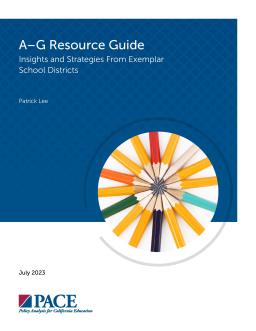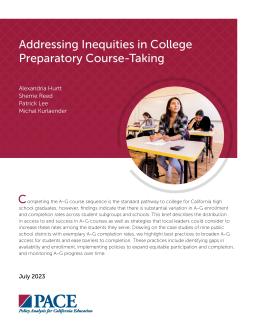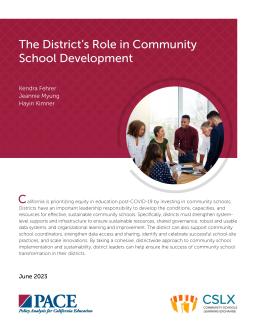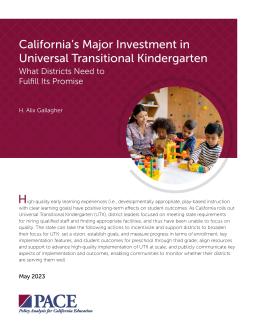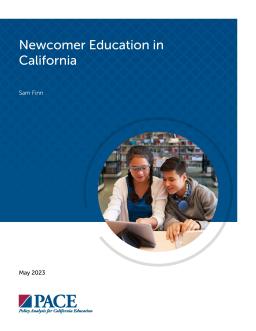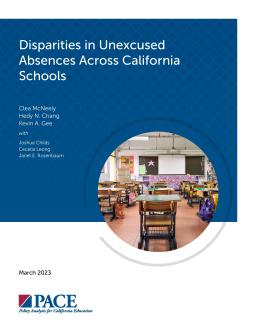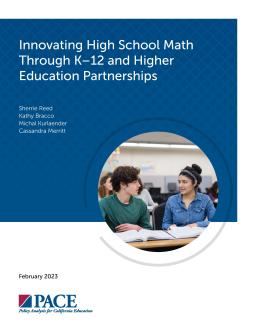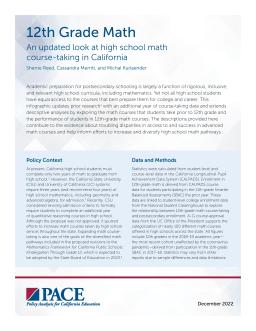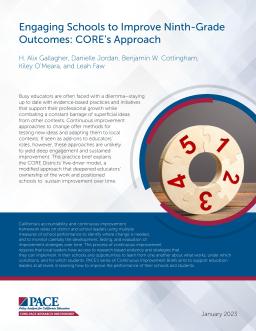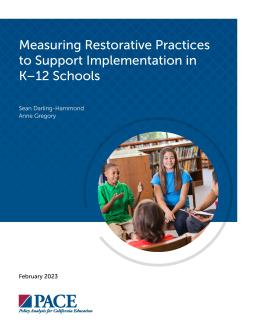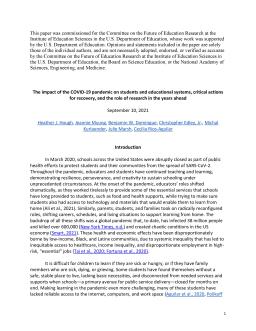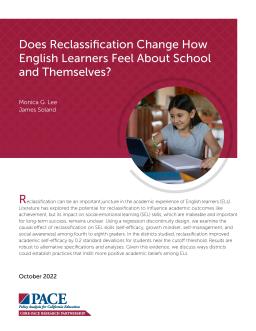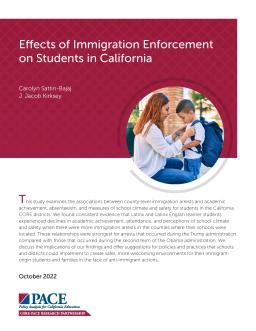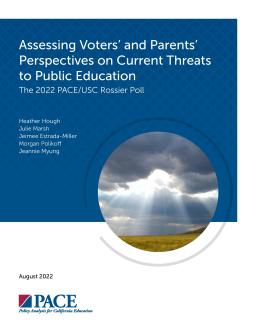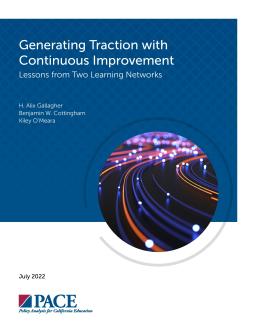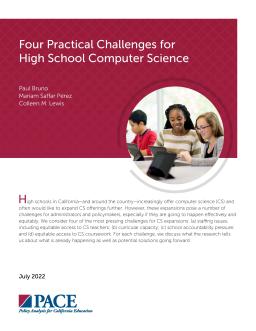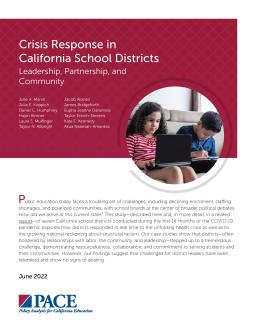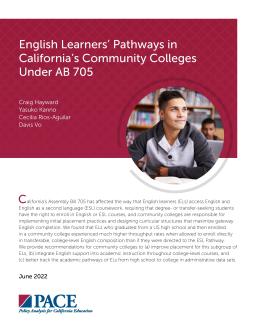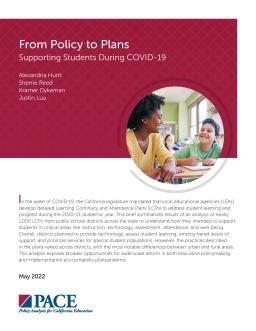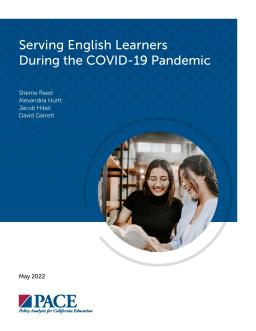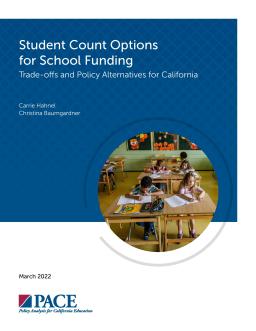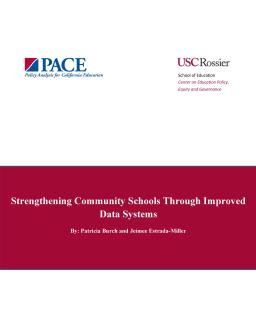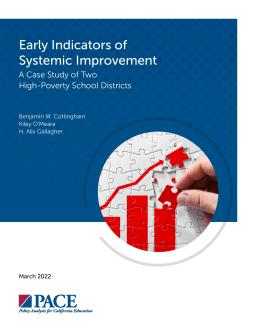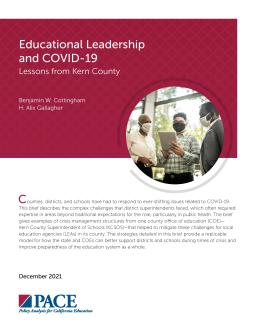Insights and Strategies From Exemplar School Districts
Published
Summary
This resource guide addresses a key problem that many district and school leaders in California face: how to increase student enrollment and success in A–G courses to reduce equity gaps in college eligibility. Developed from a qualitative research study that examined the policies and practices of nine school districts in California with A–G completion rates surpassing the overall statewide rate, the guide presents strategies, tools, and resources to address challenges with A–G course alignment, counseling, and scheduling.
Published
Summary
Completing the A–G course sequence is the standard pathway to college for CA high school graduates; however, findings indicate substantial variation in A–G enrollment and completion rates across student subgroups and schools. This brief describes the distribution in access to and success in A–G courses as well as strategies local leaders could consider to increase these rates among the students they serve. Drawing on case studies of nine public school districts with exemplary A–G completion rates, we highlight best practices to broaden A–G access for students and ease barriers to completion.
Published
Summary
California prioritizes post-COVID-19 education equity through investments in community schools. Districts must lead by strengthening system-level support, infrastructure, and sustainable resources. They should foster shared governance, robust data systems, and organizational learning. Supporting coordinators, improving data access, recognizing successful practices, and scaling innovations are crucial. A cohesive, districtwide approach ensures the success of community school transformation.
What Districts Need to Fulfill Its Promise
Published
Summary
California's Universal Transitional Kindergarten (UTK) faces challenges as districts prioritize meeting state requirements, hindering focus on quality. To address this, the state can incentivize districts by setting a vision, establishing goals, and measuring progress based on enrollment, implementation features, and student outcomes. It should align resources and support for widespread high-quality UTK implementation, while ensuring public communication of key aspects and outcomes to empower communities to monitor district performance.
Published
Summary
Every year, 150k-200k new immigrant students in California need specialized instruction and social services to succeed, but many districts struggle to provide them, resulting in dropouts and poor outcomes. Inaccessible instruction and lack of basic necessities hinder progress. The PACE report recommends developing data, instruction, and social support services to improve newcomer outcomes in California.
Published
Summary
This report finds that improving school attendance is crucial, especially with the increase in chronic absence. Data on unexcused absences should be used to create a more preventive, problem-solving, and equitable response to poor attendance. Labeling absences as unexcused affects how students and families are treated and can lead to punitive measures that may not improve attendance. Overuse of the unexcused-absence label could undermine efforts to partner with students and families to improve attendance.
Published
Summary
Access to and success in advanced math courses are not equal among high school students, with only about half of California seniors enrolling in these courses. To address this, six partnerships between university faculty and high school math specialists developed Advanced Innovative Math (AIM) courses. This report highlights the benefits of these partnerships and their common features of successful intersegmental partnerships, supplemented by case studies of each partnership.
An Updated Look at High School Math Course-Taking in California
Published
Summary
This infographic presents updated research on high school students' access to rigorous and inclusive math curricula that prepare them for college and career success. The data shows troubling disparities in access to and success in advanced math courses, which highlights the need to diversify high school math pathways. The descriptions provided can help inform efforts to increase access and equity in math education.
CORE’s Approach
Published
Summary
Educators face a dilemma of staying up-to-date with evidence-based practices while dealing with superficial ideas. Continuous improvement methods can help in testing new ideas but if seen as add-ons, they may not yield sustained improvement. This brief describes the CORE Districts’ five-driver model that deepens educators’ ownership and sustains improvement over time.
Published
Summary
This report discusses the implementation challenges of restorative practices (RPs) in schools, which have the potential to reduce the use of exclusionary discipline and improve school climates. However, schools often struggle with selective adoption, and there is a need to measure the extent to which teachers are using and students are experiencing RPs. The report provides guidance on how to measure RP implementation and why it is essential for achieving the intended impacts, including decreasing discipline, reducing racial disparities, and improving academic achievement.
How School Districts Craft Coherence Towards Continuous Improvement
Published
Summary
This study uses qualitative case study methods to explore how educators establish system-wide continuous improvement capabilities and coherence for implementation, taking into consideration the local contexts. Educators use two bridging approaches to crafting coherence: weaving and stacking. The study contributes to understanding how leaders create shared meaning and practice in complex and dynamic educational systems. The implications for both research and practice are discussed.
A Summary Brief
Published
Summary
This brief outlines findings from a study that examines the English proficiency levels and growth of newcomer English learner students in comparison to their non-newcomer peers. It was found that while newcomer students tend to have lower initial English proficiency levels, their English proficiency develops quickly. There is, however, wide variation in newcomer English level and growth patterns, and schools play an important role in fostering growth. Additionally, newcomers enter school at earlier stages of English proficiency than non-newcomer English learner peers.
Published
Summary
This study explores the impact of reclassification on social-emotional learning skills (SEL) of English learners (ELs) in grades 4 to 8. Using a regression discontinuity design, the study found that reclassification improved academic self-efficacy by 0.2 standard deviations for students near the cutoff threshold. The results suggest that reclassification can positively influence the academic beliefs of ELs and the authors provide recommendations for districts to create practices that foster such positive beliefs.
Published
Summary
This study explores the impact of county-level immigration arrests on the academic achievement, attendance, and perceptions of school climate and safety for Latinx and Latinx English learner students in California's CORE districts. The research found that there is a negative relationship between immigration arrests and these students' academic performance and school experiences. The study recommends policies and practices that can help schools and districts create safer, more welcoming environments for immigrant-origin students and families in the face of anti-immigrant actions.
The 2022 PACE/USC Rossier Poll
Published
Summary
The 2021-22 academic year in California was challenging for public education due to eight issues that threaten student learning, schools, and public education itself, including gun violence, declining enrollment, and long-term funding inadequacy. These issues also have a disproportionate impact on marginalized communities and highlight long-standing systemic inequities. In July 2022, PACE and USC Rossier School of Education conducted a poll of California voters to determine their views and priorities on public education.
Lessons from Two Learning Networks
Published
Summary
This report examines how continuous improvement is applied to educational accountability in California. It analyzes the experiences of two organizations leading networks to increase postsecondary success, aiming to improve the consistency of initiatives using continuous improvement. Key takeaways for districts, county offices, and support providers are provided.
Published
Summary
California high schools face challenges in expanding computer science (CS) programs due to staffing issues, curricular capacity, school accountability pressure, and equitable access to CS coursework. This report discusses potential solutions based on research for each challenge.
Leadership, Partnership, and Community
Published
Summary
This study of seven California school districts during the COVID-19 pandemic shows how districts responded in real-time to the crisis and structural racism. Districts showed resourcefulness, collaboration, and commitment to serving students and communities. However, challenges remain, including declining enrollment, staffing shortages, and polarized communities, with school boards at the center of broader political debates.
Published
Summary
Assembly Bill 705 in California allows ELs to enroll in college-level English composition, and colleges must design curricula and placement practices that maximize English completion. ELs who graduated from US high schools and enrolled directly in college-level English had higher throughput rates than those directed to ESL Pathway. Recommendations include improving EL placement, integrating English support in academic instruction, and better tracking EL academic pathways in administrative data sets.
Supporting Students During COVID-19
Published
Summary
An analysis of Learning Continuity and Attendance Plans (LCPs) developed by local educational agencies in California during the 2020-21 academic year showed variations in practices across districts, particularly between urban and rural areas. While districts planned to provide technology, assess student learning, and offer tiered levels of support, broader opportunities for reform and implementation accountability in education policymaking are needed post-pandemic.
Published
Summary
The COVID-19 pandemic has made it difficult for English learners (ELs) to receive the services and support they need for academic success. This report highlights how K–12 public school districts planned to support ELs during the pandemic. While many districts communicated plans to assess student progress and provide services for ELs, details on the sufficiency of these plans were lacking. The legislation mandating the plans did not include measures for adherence or monitoring student outcomes, leaving questions about the actual strategies implemented by districts and how ELs were affected.
Trade-offs and Policy Alternatives for California
Published
Summary
CA is one of six states that still use average daily attendance (ADA) to allocate state education funding to school districts. A new report suggests that 90% of districts would receive more funding under an enrollment-based formula than under the current ADA-based system, with the biggest boost going to high school districts and those with more low-income, English learner, and foster youth students. However, the report also notes that a new count method alone cannot achieve all goals, and policymakers must consider how to drive positive practices related to student attendance and engagement.
Published
Summary
Community schools are gaining attention as a promising solution for students from low-income families who have suffered economic trauma during the COVID-19 pandemic. Policymakers are investing in their expansion, and effective use of data will be crucial. This report discusses findings of a research project led by the Los Angeles County Office of Education and the USC Center on Education, Policy, Equity, and Governance and provides recommendations for implementing a data system to address community-specific needs.
A Case Study of Two High-Poverty School Districts
Published
Summary
A report examines two CA districts that have shifted their structures, policies, and culture to improve student outcomes. Both districts worked with California Education Partners to refine their continuous improvement approach and spread practices. PACE identified three key lessons for leading impactful improvement efforts: anchor work in outcome measures, invest in an aligned system of instructional learning, and use cross-role and cross-site structures. These lessons contributed to positive trends for student achievement, empowered practitioners, and built internal capacity for improvement.
Lessons from Kern County
Published
Summary
This brief examines the challenges that district superintendents faced in responding to COVID-19, often requiring expertise beyond traditional expectations. It discusses crisis management structures implemented by Kern County Superintendent of Schools as a model for how COEs can support districts and schools during times of crisis and improve the preparedness of the education system.
